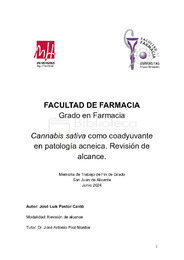Por favor, use este identificador para citar o enlazar este ítem:
https://hdl.handle.net/11000/32770Registro completo de metadatos
| Campo DC | Valor | Lengua/Idioma |
|---|---|---|
| dc.contributor.advisor | Picó Monllor, José Antonio | - |
| dc.contributor.author | Pastor Cantó, José Luis | - |
| dc.contributor.other | Departamentos de la UMH::Farmacología, Pediatría y Química Orgánica | es_ES |
| dc.date.accessioned | 2024-07-26T10:39:15Z | - |
| dc.date.available | 2024-07-26T10:39:15Z | - |
| dc.date.created | 2024-05-22 | - |
| dc.identifier.uri | https://hdl.handle.net/11000/32770 | - |
| dc.description.abstract | ANTECEDENTES: El acné vulgar es una condición dermatológica común que afecta a muchas personas en todo el mundo. Los tratamientos convencionales, como productos tópicos y medicamentos recetados, tienen limitaciones en su eficacia, tolerabilidad y efectos secundarios. Esto ha llevado a buscar alternativas terapéuticas innovadoras, como los fitocannabinoides del cannabis, conocidos por sus propiedades antiinflamatorias, antimicrobianas y reguladoras del sebo. OBJETIVO: El objetivo principal de este trabajo es revisar la literatura científica sobre el potencial terapéutico del cannabis y sus componentes en el manejo del acné vulgar. Se evaluará la viabilidad de incorporar el cannabis como complemento o alternativa a las terapias convencionales, así como su eficacia y seguridad en el tratamiento del acné. METODOLOGÍA: Se realizó una revisión bibliográfica utilizando el método PICO para identificar estudios relevantes sobre el uso de productos tópicos derivados del cannabis en el tratamiento del acné vulgar. Se consultaron bases de datos como MEDLINE, Embase, Scopus, Web of Science y Google Scholar para recopilar información actualizada. CONCLUSIONES: Los estudios revisados indican que los fitocannabinoides del cannabis, especialmente el CBD, tienen propiedades beneficiosas para el tratamiento del acné vulgar. Estos compuestos pueden modular la actividad de los sebocitos, inhibir la producción de sebo, reducir la inflamación y equilibrar la piel. Aunque la investigación está limitada por restricciones legales, los resultados preliminares apoyan la necesidad de seguir explorando los beneficios potenciales del cannabis en el tratamiento del acné. | es_ES |
| dc.description.abstract | BACKGROUND: Acne vulgaris is a highly prevalent dermatological condition affecting many individuals worldwide. Despite the availability of conventional treatments such as topical products and prescription medications, there are limitations in their efficacy, tolerability, and side effects. This has driven the search for innovative therapeutic alternatives, such as the use of phytocannabinoids derived from cannabis, known for their anti-inflammatory, antimicrobial, and sebum-regulating properties. OBJECTIVE: The main objective of this thesis is to review the scientific literature on the therapeutic potential of cannabis and its components in the management of acne vulgaris. It aims to analyze the feasibility of incorporating cannabis as a complement or alternative to existing conventional therapies, evaluating its efficacy and safety in acne treatment. METHODOLOGY: A literature review was realized using the PICO method (Population, Intervention, Comparison, Outcomes) to identify relevant studies on the use of cannabis-derived topical products in the treatment of acne vulgaris. Various databases, such as MEDLINE, Embase, Scopus, Web of Science, and Google Scholar, were consulted to gather updated scientific information on the topic. CONCLUSIONS: The reviewed studies suggest that the phytocannabinoids present in cannabis, especially CBD, have beneficial properties for the treatment of acne vulgaris. These compounds can modulate sebocyte activity, inhibit sebum production, reduce inflammation, and restore skin balance. Despite research limitations due to legal restrictions, preliminary results support the need for continued exploration of the potential benefits of cannabis in acne treatment. | es_ES |
| dc.format | application/pdf | es_ES |
| dc.format.extent | 39 | es_ES |
| dc.language.iso | spa | es_ES |
| dc.publisher | Universidad Miguel Hernández | es_ES |
| dc.rights | info:eu-repo/semantics/openAccess | es_ES |
| dc.rights | Attribution-NonCommercial-NoDerivatives 4.0 Internacional | * |
| dc.rights.uri | http://creativecommons.org/licenses/by-nc-nd/4.0/ | * |
| dc.subject | Acné vulgar | es_ES |
| dc.subject | cannabis | es_ES |
| dc.subject | fitocannabinoides | es_ES |
| dc.subject | CBD | es_ES |
| dc.subject | THC | es_ES |
| dc.subject | tratamiento dermatológico | es_ES |
| dc.subject | propiedades terapéuticas | es_ES |
| dc.subject | revisión bibliográfica | es_ES |
| dc.subject | sistema cannabinoide cutáneo | es_ES |
| dc.subject.other | CDU::6 - Ciencias aplicadas::61 - Medicina::615 - Farmacología. Terapéutica. Toxicología. Radiología | es_ES |
| dc.title | Cannabis sativa como coadyuvante en patología acneica. Revisión de alcance. | es_ES |
| dc.type | info:eu-repo/semantics/bachelorThesis | es_ES |

Ver/Abrir:
TFG JOSELE.pdf
1,36 MB
Adobe PDF
Compartir:
 La licencia se describe como: Atribución-NonComercial-NoDerivada 4.0 Internacional.
La licencia se describe como: Atribución-NonComercial-NoDerivada 4.0 Internacional.
.png)